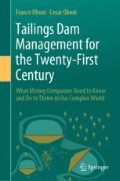Abstract
Probabilities measure the chance an event will occur. In risk assessments and project evaluations we are not dealing with absolute probabilities, but with relative probabilities (within a portfolio) over a specific time. Generally the time is one year and we use therefore annual probabilities. Do not confuse annual probabilities and frequencies which measure average number of occurrence over a certain time interval. The confusion comes from the fact that the number expressing probability and frequency is very similar, once it goes below say 1/10. Hence a probability of 1/10 has the same number—0.1—as a frequency of 1/10, but they do not mean at all the same conceptually.
Access this chapter
Tax calculation will be finalised at checkout
Purchases are for personal use only
Notes
- 1.
The term “uninformative” is common but misleading, as the simple knowledge or estimate of min-max already constitutes a very valuable piece of information.
- 2.
Because the credibility threshold may not be properly defined and people tend to instinctively place it orders of magnitude higher than the technical definition.
References
Ang A H-S, Tang WH (1975) Probability concepts in Engineering Planning and Design, Vol. I, John Wiley and sons
Carlin, BP, Louis, TA (2008). Bayesian Methods for Data Analysis (Third ed.). CRC Press
NIST/SEMATECH e-Handbook of Statistical Methods, April, 2012
Oboni C, Oboni F (2013) Factual and Foreseeable Reliability of Tailings Dams and Nuclear Reactors -a Societal Acceptability Perspective, Tailings and Mine Waste 2013, Banff, AB, November 6 to 9, 2013
Oboni C, Oboni F (2018) Geoethical consensus building through independent risk assessments. Resources for Future Generations 2018 (RFG2018), Vancouver BC, June 16–21, 2018
Oboni F, Oboni C (2016) The Long Shadow of Human‐Generated Geohazards: Risks and Crises, in: Geohazards Caused by Human Activity, ed. Arvin Farid, InTechOpen, ISBN 978-953-51-2802-1, Print ISBN 978-953-51-2801-4
[Oboni et al. 2014] Oboni F, Oboni C, Caldwell J (2014) Risk assessment of the long-term performance of closed tailings, Tailings and Mine Waste 2014, Keystone CO, USA, October 5–8, 2014
Rosenblueth E (1975) Point Estimates for Probability Moments. Proceedings of the National Academy of Sciences of the United States of America PNAS 72(10): 3812–3814
Straub D, Grêt-Regamey A (2006) A Bayesian probabilistic framework for avalanche modelling based on observations, Cold Regions Science and Technology 46: 192–203
Author information
Authors and Affiliations
Corresponding author
Rights and permissions
Copyright information
© 2020 Springer Nature Switzerland AG
About this chapter
Cite this chapter
Oboni, F., Oboni, C. (2020). Defining Probabilities of Events. In: Tailings Dam Management for the Twenty-First Century. Springer, Cham. https://doi.org/10.1007/978-3-030-19447-5_10
Download citation
DOI: https://doi.org/10.1007/978-3-030-19447-5_10
Published:
Publisher Name: Springer, Cham
Print ISBN: 978-3-030-19446-8
Online ISBN: 978-3-030-19447-5
eBook Packages: Earth and Environmental ScienceEarth and Environmental Science (R0)

